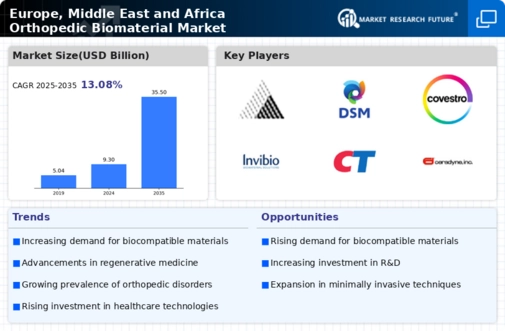Market Analysis
In-depth Analysis of Europe Orthopedic Biomaterial Market Industry Landscape
The EMEA region is witnessing a significant increase in the aging population, contributing to a higher prevalence of orthopedic disorders such as osteoarthritis and fractures. This demographic shift is a major driver for the orthopedic biomaterial market, as the elderly demographic requires advanced orthopedic solutions. A significant development in biomaterials such as ceramics, metals, polymers and also the biologics is redesigning the orthopedic biomaterial market of EMEA region. New materials which are advanced in biocompatibility and corrosion resistance properties will have a leading role, giving rise to improved orthopedic implants and devices. The growing incidence of disorders related to the joints has led to a widespread need for surgery involving replacement among individuals in the EMEA region. Biomaterials play an important role in these operations as materials such as titanium alloys and ceramic implants are widely used for hip or knee replacements which change dynamics of the market positively. A growing trend in the EMEA region is minimally invasive orthopedic procedures thus, developments and adoption of biomaterials appropriate for these operations. More and more biomaterials that encourage minimally invasive procedures, shortening recovery period as well as limiting postoperative complications are getting popular in the market. Stringent regulatory standard in Europe and other regions of the EMEA area are affecting orthopedic biomaterial market. Sticking to standards dictated by applicable regulatory bodies including European Medicines Agency (EMA) and national health authorities is highly important for gaining approval of the product on markets. The recognition of biocompatible materials and their significance among the healthcare professionals as well as patients is increasing. It is the preference for materials that blend into the natural functioning of body and enhance longevity in implanting orthopedic biomaterials, this trend characterizes dynamics of market. The firms involved in the EMEA orthopedic biomaterial market are augmenting their investments on research and development activities. Such focus is aimed at innovating R&D to introduce new biomaterials, enhance currently existing technologies and meet unmet needs in the orthopedic treatment field enabling innovation on the market. Trauma cases such as fractures among other injury related to sports are fueling the need for orthopedic biomaterials. Biomaterials that promote bone healing and regeneration play a significant role in trauma which is also one of the key drivers influencing market dynamics for orthopedic surgeons to find advanced solutions for better patient results. Competitiveness regarding the key players is found in EMEA orthopedic biomaterial market. Strategic alliances, partnerships as well mergers and acquisitions are some of the common strategies used by companies in order to strengthen their market presence, widen product portfolios among others. Ongoing developments in healthcare infrastructure across the EMEA region are influencing the orthopedic biomaterial market. The expansion of healthcare facilities and the incorporation of advanced technologies create a conducive environment for the adoption of innovative orthopedic biomaterials.

















Leave a Comment